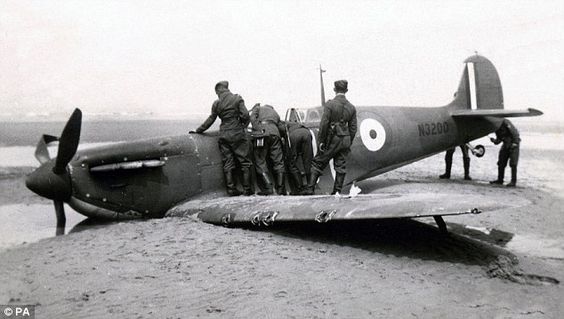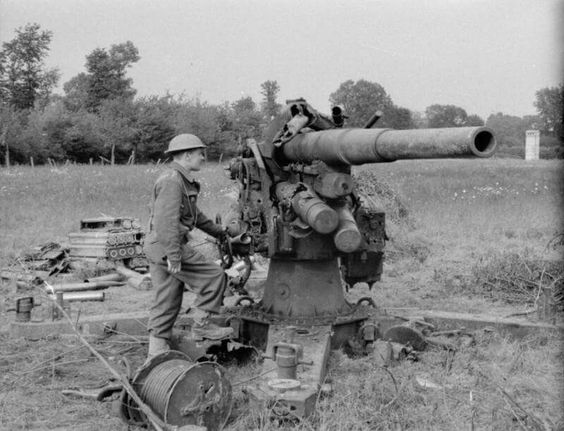Sunday 26 May 1940
 |
| Geoffrey Dalton Stephenson's Supermarine Spitfire MK1 N3200, being inspected by Germans, after it was shot down on a beach at Sangatte, near Calais on May 26, 1940. He wound up a POW at Colditz. |
Vice-Marshal Keith Park, commander of RAF No. 11 Group in southeast England, allocates 16 fighter squadrons to establish air supremacy over Dunkirk at one time, with others held in reserve.
Hitler ends the "stop order," authorizing "armored groups and infantry divisions in direction Tournai-Dunkirk."
The 10th Panzer Division attack on Calais continues, and it is clear that the end of the battle is approaching. General Guderian has given the division until the afternoon to capture the port or he will pull the division and leave its destruction to the Luftwaffe - which would be a huge slap in the face to the division. Thus, the German attacks are rabid and unrelenting.
At first light, fifteen small Royal Navy vessels arrive towing boats for an evacuation - though no evacuation has been ordered. In fact, one of the ships delivers a message to the commanding officer, Brigadier Nicholson, to continue fighting. Unlike 24 hours previously, Nicholson is worn out and sees clearly the direction in which the battle is heading. He reports that the Germans are in the north end of town and he has no more tanks or other basic necessities.
The German bombardment also begins at around the same time, 05:00. The completion of the capture of nearby Boulogne has freed additional artillery for Calais, doubling General Schaal's firepower. There also are mass Stuka attacks, followed by armored attacks. The Allied line finally breaks around 13:30, when Bastion 11 manned by French volunteers out of ammunition, falls. That sets in motion the final Allied collapse, and the Germans are soon across the defensive canals and in the city streets. The commander of the British forces, Brigadier Claude Nicholson, surrenders at 16:00. The Germans take 3500 prisoners, and only 200 wounded escape on the boats. With Calais having fallen, the panzers immediately turn and head toward Dunkirk.
German Sixth Army continues pressing against the Belgian troops holding the northern side of the Allied line. The BEF has to send reinforcements to prevent a breakthrough. It is clear that the Belgian Army - an irreplaceable part of the defensive perimeter - is on its last legs. The Belgians and British reinforcements struggle to hold Izegem, Nevele, and Ronsele, while the elite Chasseurs Ardennais stand like a rock. The Belgian reserves go into battle, and auxiliary troops are formed in the rear. The Belgians flood the canals to serve as tank traps. The Belgians tell the French at noon that "the Army has nearly reached the limits of its endurance."
The British fall back on Dunkirk without asking permission or even informing their allies. It is particularly noticeable around Lille, where it opens a gap in the line otherwise manned by the Belgians and French on either side. The Belgians are forced to fall further back themselves, while the French 1st Army essentially becomes encircled.
The British withdrawal and the Belgian weakness becomes a virtuous cycle - for the Wehrmacht. It becomes apparent by 18:00 that the British are pulling back on the Lille-Ypres sector. Meanwhile, Belgian morale plunges. King Leopold, informed of all of these movements, prepares to move his headquarters to Middelkerke. He is running out of territory to command.
The Germans attack between Courtrai and Valenciennes.
The French recapture some of the German bridgeheads over the Somme - but not all of them.
 |
| A British Cruiser Mk IV tank under repair, Blangy-sur-Ternoise. 26 May 1940. |
U-13 and U-48 leave Kiel to take up positions around the British Isles.
Convoy OA 155G departs from Southend, Convoy OB 155 departs from Liverpool. Australian/New Zealand troop convoy US 3 arrives at Cape Town.
European Air Operations: Fierce air battles continue over the Channel Ports. The Stukas pound Calais with 200 Stuka sorties.
The Luftwaffe aids the German 10th Panzer Division in Calais with attacks on Calais Citadel.
The RAF attacks railway marshaling yards in the Rhineland during the night.
Norway: Colonel Gubbins, knowing that further defense is pointless due to Operation Alphabet, withdraws his defensive line to the ferry port of Rognan. The Irish Guard makes a fighting withdrawal, leaving behind (destroying) supplies. At the port, they take ferries across the fjord - just barely leaving ahead of the Germans when the ferry breaks down. He receives air cover from a new RAF base at Bodø, which is the first RAF presence in the vicinity.
The Luftwaffe sinks British anti-aircraft cruiser Curlew (D 42, Captain Basil C. B. Brooke) in Lavangsfjord, Ofotfjord near Narvik. Nine crew perish. The Curlew had been especially helpful because it possessed the only radar in the area.
Royal Navy aircraft carrier HMS Glorious ferries Hurricanes of No. 46 Squadron to Skaanland near Narvik. The runway is sod, but Hawker Hurricanes are sturdy planes.
The Luftwaffe continues its gradual reinforcement of General Dietl's force in Narvik, bringing in 81 men of the 1st Fallschirmjaeger Regiment.
Anglo/Belgian Relations: Prime Minister Churchill meets with Belgian Prime Minister Pierlot and Foreign Minister Spaak.
Anglo/French Relations: French Prime Minister Paul Reynaud visits Churchill in London.
Italy: Mussolini meets with Army Chief of Staff Pietro Badoglio and Air Marshal Italo Balbo in Rome to discuss his growing urge to join the Axis conflict. Badoglio states that Italy is unprepared for any conflict and illustrates this by pointing out that the army does not even have enough shirts. Mussolini replies:
History cannot be reckoned by the number of shirts.He explains that he needs "a few thousand dead" to be able to hold his head high at the peace table. Mussolini orders Badoglio to prepare his forces for an invasion of France on 5 June 1940.
German Military: Admiral Otto Schniewind, Chief of Staff of the Seekriegsleitung (Maritime Warfare Command), reaches a conclusion: "Evacuation of (BEF) troops without equipment …. is conceivable by means of large numbers of smaller vessels …. even from the open coast."
British Military: General Sir Edmund Ironside becomes Commander-in-chief of the Home Forces. Sir John Greer Dill replaces Ironside as Chief of the Imperial General Staff. While done politely, and with Ironside putting the best positive spin about it in his diary, there is an element of scapegoating for the disastrous course of the battle on the Continent. In addition, Ironside has proven undiplomatic with the French.
French Military: General Maxime Weygand issues Ordre Général d' Operation No. 1184 3/FT:
The battle on which the fate of the country depends will be fought without any idea of retreat, on the line which we hold today.US/Latin American Relations: The US minister in Uruguay, Edwin Wilson, follows up on his previous report of undue German influence within the Uruguayan government. He reports by telegram to Secretary of State Cordell Hull that the Uruguayan government has had its police searching the homes and businesses of German nationals. Wilson states that the police are using "rough methods" and that tension is arising between the two governments as a result.
American Homefront: President Roosevelt gives his fireside chat "On National Defense." He emphasizes that the US has become more secure since his inauguration, and emphasizes:
There is nothing in our present emergency to justify a retreat from any of our social objectives.German Homefront: Prince Wilhelm of Prussia, 33, son of Wilhelm, German Crown Prince, perishes of wounds sustained in France.
British Homefront: A national day of prayer for the troops is held in the UK. Westminster Abbey is packed.
 |
| A British officer examines a knocked-out German 88 mm anti-aircraft gun, May 26-29, 1940. |
May 1940
May 1, 1940: British Leave ÅndalsnesMay 2, 1940: British Depart Namsos
May 3, 1940: Many Norwegians Surrendering
May 4, 1940: Bader Returns
May 5, 1940: HMS Seal Survives
May 6, 1940: Allies Focus on Narvik
May 7, 1940: In The Name of God, Go!
May 8, 1940: Exit Chamberlain
May 9, 1940: Enter Churchill
May 10, 1940: Fall Gelb
May 11, 1940: Eben Emael Surrenders
May 12, 1940: Germans at Sedan
May 13, 1940: Rommel at Work
May 14, 1940: German Breakout in France
May 15, 1940: Holland Surrenders
May 16, 1940: Dash to the Channel
May 17, 1940: Germans Take Brussels
May 18, 1940: Germans Take Antwerp
May 19, 1940: Failed French Counterattack
May 20, 1940: Panzers on the Coast
May 21, 1940: Battle of Arras
May 22, 1940: Attacking Channel Ports
May 23, 1940: British Evacuate Boulogne
May 24, 1940: Hitler's Stop Order
May 25, 1940: Belgian Defenses Creaking
May 26, 1940: Operation Dynamo
May 27, 1940: King Leopold Surrenders
May 28, 1940: The Allies Take Narvik
May 29, 1940: Lille Falls
May 30, 1940: Operation Fish
May 31, 1940: Peak Day for Dynamo
2020
No comments:
Post a Comment